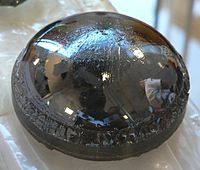
Photo from wikipedia
Plasma-sprayed yttria (Y2O3) coatings on commercial high-density graphite (HDG) as a chemical barrier coating are presently being explored for uranium-zirconium alloy melting crucibles in pyrochemical reprocessing of spent metallic fuel… Click to show full abstract
Plasma-sprayed yttria (Y2O3) coatings on commercial high-density graphite (HDG) as a chemical barrier coating are presently being explored for uranium-zirconium alloy melting crucibles in pyrochemical reprocessing of spent metallic fuel of future fast breeder reactors. The performance and durability of Y2O3 coatings for high-temperature exposure up to 1,823 K for multiple batch operations are critical to reducing solid active waste generation. However, plasma-sprayed Y2O3 coatings on HDG experience large thermal mismatch stresses due to the difference in the coefficient of thermal expansion (CTE) value of ∼8 × 10−6 K−1 for Y2O3 and ∼4 × 10−6 K−1 for HDG, combined with partial active oxidation of HDG interface leading to premature cracking and spallation of the coating. Silicon carbide (SiC) coating with intermediate CTE (∼6 × 10−6 K−1) offers superior oxidation protection for HDG, which can suitably be used as an interlayer to improve the durability of Y2O3 coatings. In the present work, SiC interlayer coating is developed on HDG substrates using conventional coating techniques such as pack cementation and chemical vapor deposition techniques for subsequent deposition of Y2O3 topcoat by plasma spraying. The thermal fatigue studies simulating uranium melting condition by isothermal hold at 1,723, 1,773, and 1,823 K for 1 h showed twofold improvements in the life of Y2O3 coatings with SiC interlayer. The evolution of thermal cycling damage and failure mechanisms are discussed. The role of interfacial microstructure, the stability of phases, and the underlying mechanisms for life enhancement in the presence of SiC interlayer for plasma-sprayed Y2O3 coating for high-temperature applications are highlighted.
Journal Title: Materials Performance and Characterization
Year Published: 2021
Link to full text (if available)
Share on Social Media: Sign Up to like & get
recommendations!